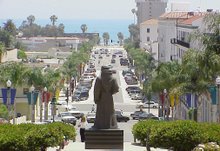Wending Our Way through the Underbelly by Layla Windwillows
 Birds have an appreciation for the markers on the river trail and they demonstrate it with enthusiasm. The weathering and corrosion of the metal industrial tools contributes to the capture of guano and it can be a challenge removing it, even with the variety of brushes and sponges we use. Curiously, there was another type of splatter: red and dark green paint. That’s wild. It took quite a bit of elbow grease but we got the rust stains, guano, and paint off. Then we repainted the lettering. Odd that so many (but not all) of the markers have the letters painted with a dusty, pinkish paint.
Birds have an appreciation for the markers on the river trail and they demonstrate it with enthusiasm. The weathering and corrosion of the metal industrial tools contributes to the capture of guano and it can be a challenge removing it, even with the variety of brushes and sponges we use. Curiously, there was another type of splatter: red and dark green paint. That’s wild. It took quite a bit of elbow grease but we got the rust stains, guano, and paint off. Then we repainted the lettering. Odd that so many (but not all) of the markers have the letters painted with a dusty, pinkish paint. 





